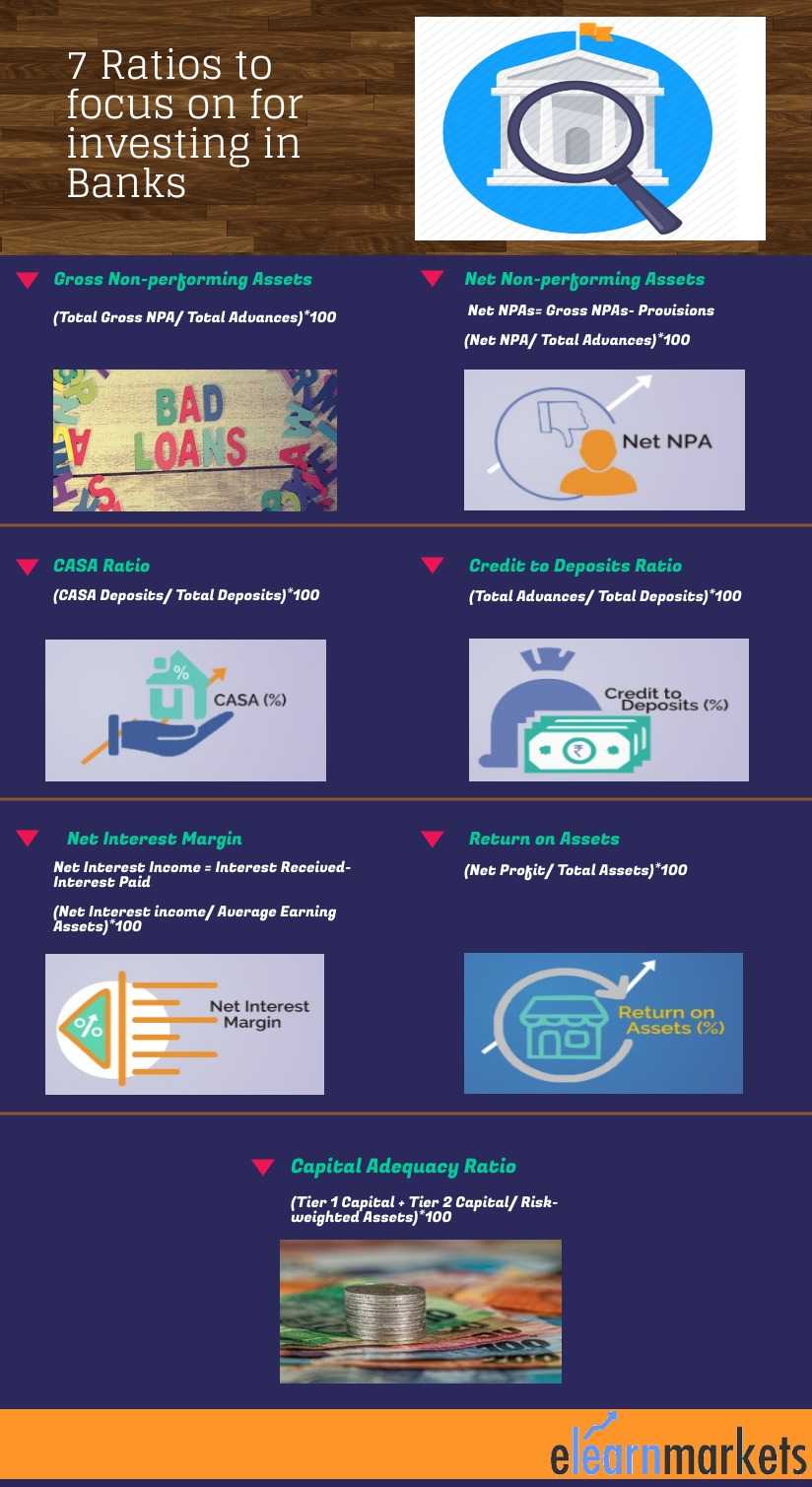Investing in Banks requires a careful analysis of financial data.
This is generally done by examining the profit and loss account, balance sheet, and cash flow statement but this can be a time-consuming process.
So how easy would it be for you if you could find a shortcut solution for the same? Read to find out.
So an easier way to find out about a Bank’s performance and before investing in banks is to look at their ratio which is available in our StockEdge App.
| Table of Contents |
|---|
| Gross Non-performing assets (NPAs) |
| Net Non-Performing assets (NPA) |
| CASA Ratio |
| Credit to deposit Ratio |
| Net Interest Margin |
| Return on Assets |
| Capital adequacy ratio |
Analyzing Ratios helps in knowing how the bank has been performing and also makes it easier for investors to compare it with other banks within the same industry.

1. Gross Non-performing assets (NPAs):-
Gross NPAs are the total of all loan assets that are classified as Non-performing assets as per RBI guidelines. It shows how much of a bank’s loans are in danger of not being repaid. It is one of the most important ratios to consider before investing in banks.
If interest is not received for 90 days, a loan turns into NPA.
Gross NPA reflects the quality of the loans made by the bank. A very high gross NPA Ratio means the bank’s asset quality is in very poor shape.
2. Net Non-Performing assets (NPA):-
Net NPAs are those types of NPAs in which the bank has deducted the provision regarding NPAs. (Net NPAs is Gross NPAs – Provisions). Net NPA is a better indicator of the health of the bank. It shows the actual burden of the bank.
A higher level of NPA increases the amount of provision thereby impacting the profitability of the bank. It also impacts the Net interest margin of the bank.
3. CASA Ratio:-
CASA stands for Current Account and Saving Account.
Different kinds of deposits like current account, saving account and term deposits forms the major source of funds for banks. CASA deposit is generally a cheap source of fund for banks if its high.
Higher CASA Ratio helps the bank in improving net interest margin as these deposits come with an Interest payment which is negligible for Banks.
The Current account does not attract any Interest Burden but term deposits come with a higher interest burden compared to Savings Account deposits.
Learn from Experts : Common Sense Investing
A low CASA Ratio suggests that the bank is not efficient, as it has to pay higher rates on more expensive types of deposits, which can hurt its Net interest margins. This ratio should be considered before investing in banks.
4. Credit to deposit Ratio:-
A credit to deposit ratio is the ratio of how much a bank lends out of the deposit it has mobilized. It helps in assessing a bank’s liquidity and indicates its health.
The ideal Credit to Deposit Ratio is between 80%-90%.
This means that the Bank is lending this percent from the Total deposits that it has. Lending is the main business of the bank so this ratio should be high.
If the ratio is too low, it means the bank may not be earning as much as they should be. If the ratio is too high, it means that the bank might not have enough liquidity to cover any unforeseen fund requirements, which may affect capital adequacy and asset-liability mismatch.
This ratio should be checked before investing in banks.
5. Net Interest Margin:-
Net Interest margin is an another ratio to consider before investing in banks. It is the difference between the interest income generated by the bank on loans and the amount of interest paid out to their lenders on savings accounts and deposits, relative to the amount of their Interest earning assets.
NIMs will be higher for the bank with higher low-cost deposits (CASA) or high lending rates.
Suggested Read: 22 Important Banking Terms you need to know
If the non-performing assets (NPAs) of the bank are rising, the interest earned would fall and NIM will decline. Low NIM and High NPA is bad combination for the bank.
6. Return on Assets:-
Return on Assets Ratio is the net profit generated by the bank on its Total Assets. It helps to know-how management is using its assets to generate more income.
The higher the portion of average earnings assets, the better would be the resulting returns on total assets.
A low or declining Return on Assets ratio means that the bank is not able to utilize its assets efficiently.
7. Capital adequacy ratio:-
Capital Adequacy Ratio is the ratio of a bank’s Total capital (tier 1 + tier 2) in relation to its risk-weighted assets. This should be taken into consideration before investing in banks.
It is decided by the central banks and bank regulators to prevent commercial banks from taking excess leverage and becoming insolvent in the process.
Under Basel III, a bank’s tier 1 and tier 2 capital must be at least 8% of its risk-weighted assets. The minimum capital adequacy ratio (including the capital conservation buffer) is 10.5%.
The minimum capital adequacy ratio ensures that the bank has enough cushion to absorb a reasonable amount of losses before they become insolvent and consequently lose depositors funds. A high CAR means that the bank is safe.
These are the ratios that can help you to know which bank is weak and is not worthwhile investing.
Although this is not a foolproof method it is a good way to run a fast check on a Bank’s health.
Key Takeaways:
- Analyzing Ratios helps in knowing the performance and if one should go for investing in banks or not.
- Gross NPAs are the total of all loan assets that are classified as Non-performing assets as per RBI guidelines.
- Net NPAs are those types of NPAs in which the bank has deducted the provision regarding NPAs.
- A credit to deposit ratio is the ratio of how much a bank lends out of the deposit it has mobilized.
- Return on Assets Ratio is the net profit generated by the bank on its Total Assets. It helps to know-how management is using its assets to generate more income.
Happy Learning!








